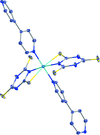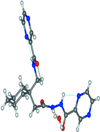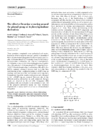issue contents
August 2014 issue

Cover illustration: [Mn3(OAc)6(py)2(H2O)2]n (OAc is acetate and py is pyridine), a candidate for a single-chain magnet, is a true one-dimensional coordination polymer. The structural features are compatible with a single-chain magnet behaviour, as confirmed by preliminary magnetic studies. The image shows part of the polymeric chain, limited to two Mn1 Mn2 units related by an inversion centre. Displacement ellipsoids are drawn at the 50% probability level. See Caballero-Jiménez, Reyes Ortega, Bernès & Escudero [Acta Cryst. (2014), C70, 754-757].
Mn2 units related by an inversion centre. Displacement ellipsoids are drawn at the 50% probability level. See Caballero-Jiménez, Reyes Ortega, Bernès & Escudero [Acta Cryst. (2014), C70, 754-757].
research papers
























 access
access















letters to the editor



 journal menu
journal menu






































